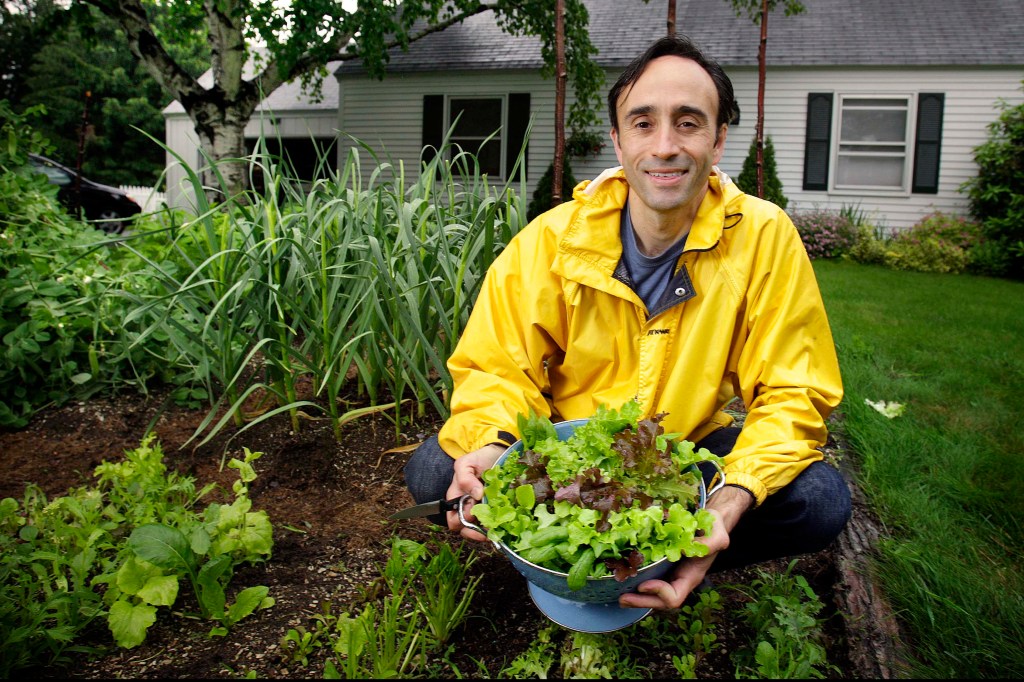Michelle Obama announced steps last week to preserve the White House kitchen garden through future administrations, including a newly unveiled expansion and $2.5 million in private donations to maintain it. Creating the garden and using it to promote healthy eating has been a hallmark of the first lady’s work in the White House. It happened, at least in small part, as a result of lobbying from Roger Doiron of Scarborough.
Doiron was director of Kitchen Gardens International, a nonprofit focused on helping people grow their own food. Just as the White House garden has grown – with the latest expansion, it’s 2,800 square feet – Doiron’s group has grown and changed. It’s now called SeedMoney, and it offers grants and a crowdsourcing platform to groups and individuals launching gardens at schools, vacant city blocks, juvenile detention centers, libraries and other community spaces.
We talked with Doiron about what it has been like to see the White House garden thrive. This interview has been edited for length and clarity.
Q: Take us back to the beginning. What was your part in making this garden grow?
A: I tell people that my role was the noisemaker-in-chief… We started our campaign at the beginning of 2008 (during the primaries). There were many candidates at the time, and they were all talking about issues that were important to various American citizens and people abroad. I saw an opportunity to interject into that conversation something about healthy food and gardens through a competition that was being sponsored through the United Nations Foundation called On Day One. They were crowdsouricng good ideas for the next president to implement upon taking office.
We gave the campaign a name, “Eat the View,” and I created a couple of amateurish but viral videos. In one, I tore up a part of our own south lawn – I just happen to live in a house that is white in Scarborough – to show people, I’m a father of three planting a garden in my backyard… Some of that authenticity came through.
We then posted an online petition on Facebook. We had over 100,000 signatures. We had absolutely overwhelming media coverage… We got to this point with our campaign in January 2009, the month that President Obama was going to be inaugurated, that we had attracted all this attention, but at the same time we had no reason to believe that we had managed to catch the attention of the Obama administration.
What I ended up doing – this sounds a little naive on my part – I picked up the phone and called the White House switchboard. I knew the name of Michelle Obama’s policy director at that time. I asked to be put through to her. It was early on, and there was no sort of firewall in place to prevent people like me from doing that. I had a short but effective conversation with her… She said, “Don’t you worry. We’re very much aware of how much support this idea has.”
Q: It must be so rewarding to see what the garden has become.
A: First lady Obama has done such a wonderful job from start to finish with this project. I’m so grateful to her for her leadership in this area, especially now to see that she’s really thought it through right to the end, to make sure this isn’t something that is going to be connected just to their term in office but that will continue to inspire people here and around the world for many years to come.
Q: As you’ve watched this election unfold, have you worried about the future of the garden?
A: I do think about it.
When I think way back to when we first got the idea started, there was a tiny little part of me that felt guilty for proposing a planting of the garden as the first thing the president should do on taking office, because of the scale of the problems that we face. But then I took a moment and reflected on it and said, we do really need to focus on things that are doable, things that have the power to inspire people. I’m thinking of those things again. I certainly want us to tackle these bigger picture issues, like fighting climate change and seeing through health care reform, but it’s really important that we don’t lose track of the little things that can inspire people and energize people. Whoever is the next president is going to have many decisions to make, and I would hope that (continuing the garden) would be a no-brainer.
It wasn’t well-publicized, but during the administration of Bill Clinton there was a very small rooftop garden installed… There’s every reason to believe that a Clinton administration would seek to maintain the White House garden.
In a Trump administration, it’s really anybody’s guess. He has gone on the record as saying, if he were to be president he would want to make some touchups at the White House. I don’t know how we can interpret that language. To my knowledge, he has not really made healthy food part of his political platform whatsoever.
Q: Have you visited the White House garden yourself?
A: Yes, in September 2010. It was quite a moving day.
I printed out our petition, all 100,000 signatures, on the most eco-friendly paper I could find… My request to Sam Kass (longtime advisor to the first lady and then the White House food initiative coordinator) was that he hand the petition over to Michelle Obama, that she leave it on a desk or a shelf just to see how many people she made happy by doing what she did, but that after a certain amount of time she ceremoniously toss the petition onto the White House compost pile, so that all those names could become part of the garden.
Send questions/comments to the editors.


